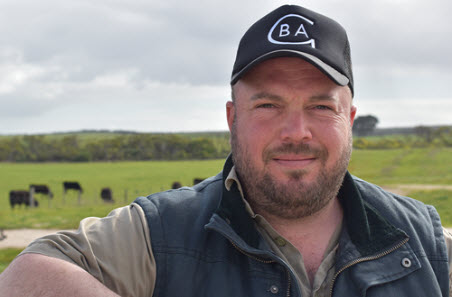Blue Lake Station’s winning MSA formula
29 September 2017
It’s only been in operation for three years, but Blue Lake Station at Kongorong is already building a reputation for supplying premium beef to the domestic market with a focus on environmentally sustainable production systems.

Last night, Blue Lake Station’s owners, Michael Famularo and James Sackl, of Golden Triangle Meats, were recognised for their efforts when they won the 2017 Meat Standards Australia (MSA) Excellence in Eating Quality Most Outstanding Beef Producer award for South Australia, presented at Gawler. (Click here for more details about the SA MSA Awards)
The award recognised any production system, with the exclusion of accredited grainfed beef, which achieved the highest combination of compliance to MSA requirements and eating quality performance as represented by the MSA Index.
Mr Famularo said a focus on breeding for temperament and ensuring low-stress handling in all operations were the key reasons why their beef consistently met MSA minimum requirements and measures for top eating quality at processing.
“Our aim is to consistently produce top quality beef for consumers while employing a sustainable system,” Mr Famularo said.
Mr Famularo and Mr Sackl run a Black Angus breeding herd on the property where they have also built an undercover feeding facility for finishing cattle.
They have a medium-term goal of establishing their own brand and integrated vertical supply chain that includes online sales to anywhere in the world.
Currently, they aim to turn off 1600 Angus steers annually from their own herd, bought-in cattle and cattle that are contract fed for clients.
Mr Famularo said the most important factor effecting meat eating quality was reducing animal stress and at Blue Lake Station a keen watch was kept on the meat ultimate pH feedback to gauge the stress levels of the cattle.
“To date, we are meeting the requirements for MSA for meat pH and this has reinforced the value of using low-stress handling, especially right before transport, and providing cattle with extra minerals in the two weeks before they leave the property,” he said.
“It might be a cliché, but I think having happy cattle is the key to our MSA results.”
Mr Famularo said Blue Lake Station’s Black Angus herd was based on genetics from the Glatz Black Angus stud, which had a breeding emphasis on temperament.
He said calving occurred on improved phalaris and ryegrass pastures, where calves also had access to extra protein and grain supplements from three weeks of age and stress could be taken off cows.
“We sell in a direct supply arrangement to Coles supermarkets at a liveweight of 580kg to 625kg," Mr Famularo said.
“We supplementary feed the calves in the paddock to set the rumen up for the best potential feed conversion efficiency and easy transition to the feedlot."
Mr Famularo said maintaining good herd health was also vital. All vaccinations are kept up-to-date and mineral supplements provided to avoid any deficiencies.
“We joined Meat Standards Australia because we wanted a genuine, unbiased rating system to measure and monitor our cattle performance in meeting our expectations and those of the market,” Mr Famularo said.
“The MSA system identifies where we are doing well. But if there is even an issue highlighted by the MSA results, we want to be able to trace that back to a particular feed or point in time.”
Mr Famularo said for the future, the aim was to be operating a fully sustainable production system for supply of premium beef – under the Blue Lake Station brand – to Australia and the world.
In order to do this, Blue Lake Station has built a state of the art enclosed feedlot that is currently working towards accreditation with National Feedlot Accreditation Scheme (NFAS) so it will be able to produce beef under the Australian Standards for Grainfed beef.
The feedlot holds 400 head with surrounding paddocks supporting the backgrounding of weaners.
Mr Famularo said the costs of fully enclosing the Blue Lake Station feedlot were starting to be recouped in superior weight gains by cattle.
Already, Blue Lake Station recycles and re-uses its effluent with absorbent bedding that is processed to compost, waste is recycled into protein for fish food and the feedlot uses solar power.
For more information about the MSA system, visit: www.mla.com.au/msa
To look at your own carcase feedback and use the MSA Index calculator, visit: www.mymsa.com.au


